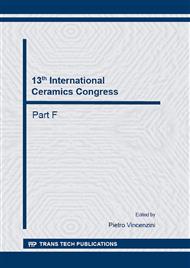[1]
I.W. Donald, Waste immobilization in glass and ceramic based hosts: radioactive, toxic and hazardous wastes, John Wiley & Sons, (2010).
DOI: 10.1002/9781444319354
Google Scholar
[2]
P. Colombo, G. Brusatin, E. Bernardo, G. Scarinci, Inertization and reuse of waste materials by vitrification and fabrication of glass-based products, Curr. Opin. Solid St., Mat. 7 (2003) 225-239.
DOI: 10.1016/j.cossms.2003.08.002
Google Scholar
[3]
P. A Bingham, R. J. Hand, Vitrification of toxic wastes: a brief review, Advances in Applied Ceramics 105 (2006) 21-31.
DOI: 10.1179/174367606x81687
Google Scholar
[4]
R.D. Rawlings, J.P. Wu, A. R. Boccaccini, Glass-ceramics: their production from wastes-a review, J. Mat. Sci. 41 (20063) 733-761.
DOI: 10.1007/s10853-006-6554-3
Google Scholar
[5]
W. Hőland, G. Beall, Glass-Ceramics Technology, The American Ceramics Society, Westerville, (2002).
Google Scholar
[6]
R.K. Chinnam,.A.A., Francis, J. Will, E. Bernardo, A.R. Boccaccini, Review: functional glasses and glass-ceramics derived from iron rich waste and combination of industrial residues, J. Non-Crystalline Solids 365 (2013) 63-74.
DOI: 10.1016/j.jnoncrysol.2012.12.006
Google Scholar
[7]
Information on http: /www. neg. co. jp/arch.
Google Scholar
[8]
A. Karamanov, I. Gutzow, I. Chomakov, Synthesis of wall-covering glass-ceramics from waste raw material, Glastech. Ber., Glass Sci. Tech. 67 (1994) 227-231.
Google Scholar
[9]
A. Karamanov, Granite-like materials from hazardous wastes obtained by sinter-crystallization of glass frits, Advances in Applied Ceramics 108(2009) 14-21.
DOI: 10.1179/174367608x364302
Google Scholar
[10]
A. Karamanov, G. Taglieri, M. Pelino, Iron-rich sintered glass-ceramics from industrial wastes, J. Am. Ceram. Soc. 82 (1999) 3012-3016.
DOI: 10.1111/j.1151-2916.1999.tb02195.x
Google Scholar
[11]
A. Karamanov, M. Pelino, Crystallization phenomena in iron rich glasses, J. Non-Crystalline Solids 281 (2001) 139-151.
DOI: 10.1016/s0022-3093(00)00436-1
Google Scholar
[12]
A. Karamanov, G. Taglieri, M. Pelino M., Sintering behavior and properties of iron-rich glass-ceramics, J. Am. Cer. Soc. 87 (2004) 1571-1574.
DOI: 10.1111/j.1551-2916.2004.01571.x
Google Scholar
[13]
A. Karamanov, G. Taglieri, M. Pelino, Sintering in nitrogen atmosphere of iron-rich glass-ceramics, J. Am. Cer. Soc. 87 (2004) 1354-1357.
DOI: 10.1111/j.1151-2916.2004.tb07734.x
Google Scholar
[14]
A. Karamanov, M. Aloisi, M. Pelino, Vitrification of copper flotation waste, J. Hazardous Mat. 140 (2007) 333-339.
DOI: 10.1016/j.jhazmat.2006.09.040
Google Scholar
[15]
L. Maccarini Schabbach, F. Andreola, E. Karamanova, I. Lancellotti, A. Karamanov, L. Barbieri, Integrated approach to establish the sinter-crystallisation ability of glasses from secondary raw material, J. Non-Crystalline Solids 357 (2011) 10–17.
DOI: 10.1016/j.jnoncrysol.2010.10.006
Google Scholar
[16]
A. Karamanov, L. Maccarini Schabbach, E. Karamanova, F. Andreola, L. Barbieri, B. Ranguelov, G. Avdeev, I. Lancellotti, Sinter-crystallization in air and inert atmospheres of a glass from pre-treated municipal solid waste bottom ashes, J. Non-Crystalline Solids 389 (2014).
DOI: 10.1016/j.jnoncrysol.2014.02.009
Google Scholar
[17]
A. Karamanov, R. Di Gioacchino, P. Pisciella P. Pelino M., S. Hreglich, Viscosity of iron-rich glasses from industrial wastes, Glass Technology 43 (2002) 34-38.
Google Scholar
[18]
A. Karamanov, I. Gutzow, I. Penkov, Diopside marble-like glass-ceramics, Glastech. Ber., Glass Sci. Tech. 67 (1994) 202-208.
Google Scholar
[19]
D.J.M. Burkhard, T. Scherer, Surface oxidation of basalt glass/liquid, J. Non-Crystalline Solids 352 (2006) 241–247.
DOI: 10.1016/j.jnoncrysol.2005.11.029
Google Scholar


